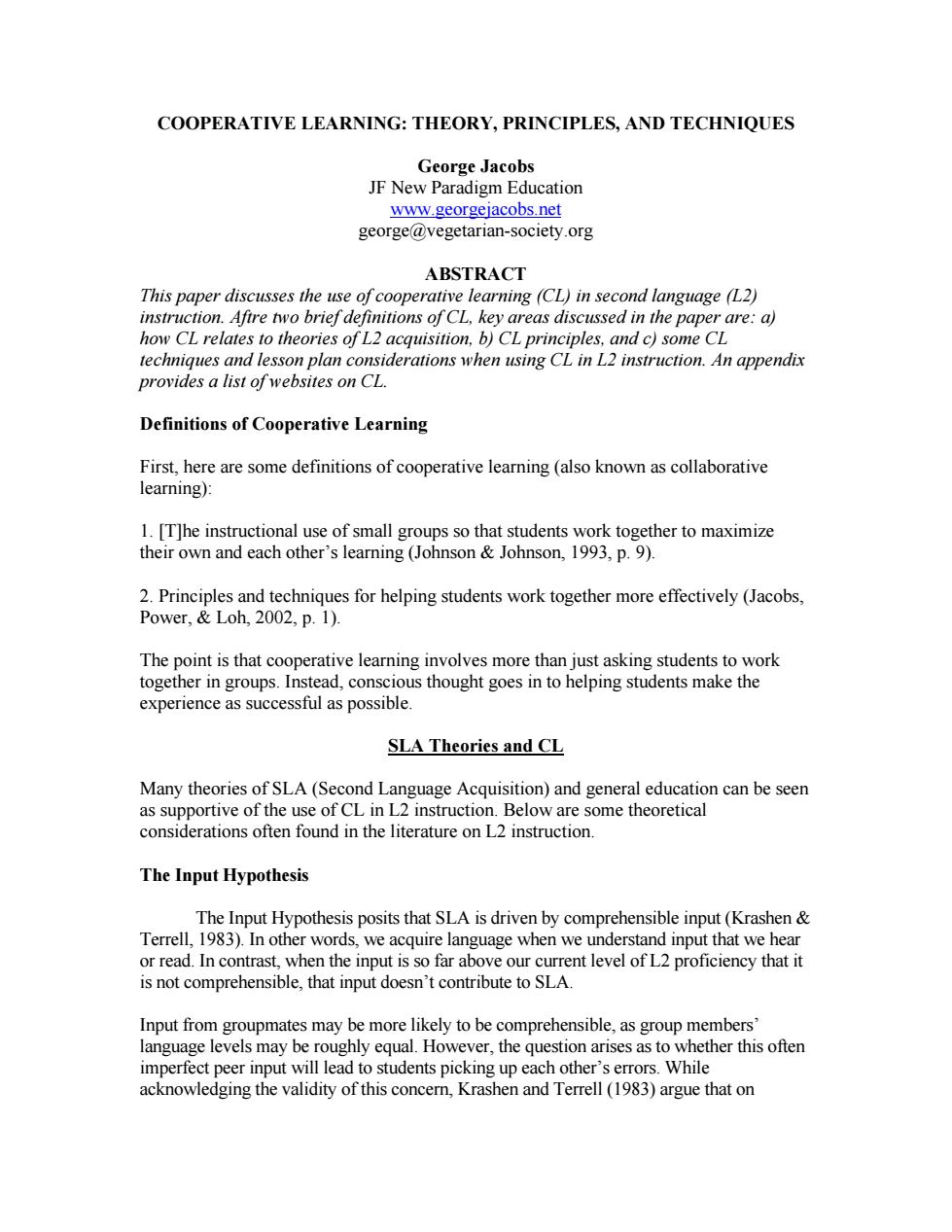正在加载图片...

COOPERATIVE LEARNING:THEORY,PRINCIPLES,AND TECHNIQUES George Jacobs JF New Paradigm Education www.georgejacobs.net george@vegetarian-society.org ABSTRACT This paper discusses the use of cooperative learning (CL)in second language (L2) ion.Afre two brief definitions of CL.key areas discussed in the aper are:a) how CL relates to theories of L2 ac when using truction.An appendix ites on Cl Definitions of Cooperative Learning First,here are some definitions of cooperative learning(also known as collaborative learning): [T]he instructional use of small groups so that students work together to maximize their own and each other's learning (Johnson Johnson,1993,p.9). 2.Principles and techniques for helping students work together more effectively (Jacobs Power,Loh,2002,p.1). The point is that cooperative learning involves more than just asking students to work together in groups.Instead,conscious thought goes in to helping students make the experience as successful as possible. SLA Theories and CL Many theories of SLA(Second Lar eral education can be seen as s oportive of the of CL in L2 inst ome theoretical considerati uctio ofte ruction The Input Hypothesis The Input Hypothesis posits that SLA is driven by comprehensible input(Krashen& Terrell,1983).In other words,we acquire language when we understand input that we hear or read.In contrast,when the input is so far above our current level of L2 proficiency that it is not comprehensible,that input doesn't contribute to SLA. Input from groupmates may be more likely to be comprehensible,as group members' language levels may be roughly equal.However,the question arises as to whether this often imperfect peer input will lead to students picking up each other's errors.While acknowledging the validity of this concern,Krashen and Terrell (1983)argue that on COOPERATIVE LEARNING: THEORY, PRINCIPLES, AND TECHNIQUES George Jacobs JF New Paradigm Education www.georgejacobs.net george@vegetarian-society.org ABSTRACT This paper discusses the use of cooperative learning (CL) in second language (L2) instruction. Aftre two brief definitions of CL, key areas discussed in the paper are: a) how CL relates to theories of L2 acquisition, b) CL principles, and c) some CL techniques and lesson plan considerations when using CL in L2 instruction. An appendix provides a list of websites on CL. Definitions of Cooperative Learning First, here are some definitions of cooperative learning (also known as collaborative learning): 1. [T]he instructional use of small groups so that students work together to maximize their own and each other’s learning (Johnson & Johnson, 1993, p. 9). 2. Principles and techniques for helping students work together more effectively (Jacobs, Power, & Loh, 2002, p. 1). The point is that cooperative learning involves more than just asking students to work together in groups. Instead, conscious thought goes in to helping students make the experience as successful as possible. SLA Theories and CL Many theories of SLA (Second Language Acquisition) and general education can be seen as supportive of the use of CL in L2 instruction. Below are some theoretical considerations often found in the literature on L2 instruction. The Input Hypothesis The Input Hypothesis posits that SLA is driven by comprehensible input (Krashen & Terrell, 1983). In other words, we acquire language when we understand input that we hear or read. In contrast, when the input is so far above our current level of L2 proficiency that it is not comprehensible, that input doesn’t contribute to SLA. Input from groupmates may be more likely to be comprehensible, as group members’ language levels may be roughly equal. However, the question arises as to whether this often imperfect peer input will lead to students picking up each other’s errors. While acknowledging the validity of this concern, Krashen and Terrell (1983) argue that on